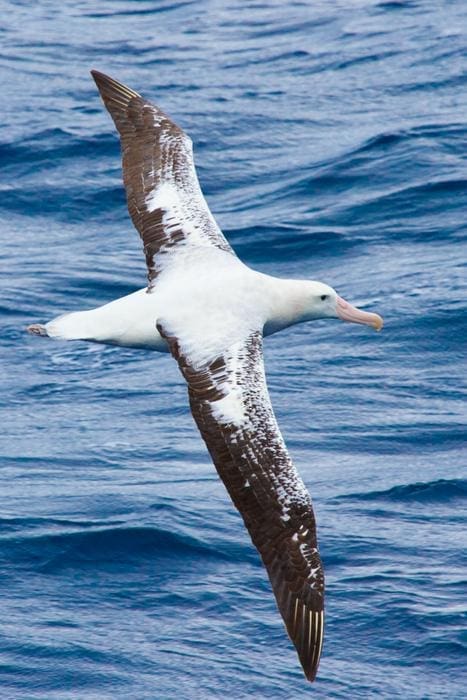New research shines a spotlight on the unforeseen challenges facing one of the world’s most iconic seabirds, the albatross, during extreme ocean storms.
Known for their remarkable endurance and expansive wingspans, which enable them to navigate thousands of miles across vast ocean expanses, albatrosses depend on the wind to stay aloft, conserve energy, and search for food. However, a recent study reveals a critical limitation to their reliance on these winds: when storms intensify beyond a certain threshold, these expert fliers struggle to find food.

The study, led by the University of Liverpool and published in Current Biology, examined two albatross species in the turbulent skies and waters of South Georgia in the South Atlantic.
Researchers observed that during extreme weather, wandering albatrosses – a species with a wingspan reaching up to 3.4 meters – fed far less frequently than in moderate conditions. This behavior suggests that while albatrosses are well adapted to the Southern Ocean’s typical windy weather, the increasing prevalence of extreme storms poses new risks to their survival.
By attaching lightweight tracking devices to birds on South Georgia (in the southwest Atlantic Ocean) by scientists from the British Antarctic Survey, the research team collected detailed movement data, tracking where and when the birds rested, flew, or fed.
They combined this information with satellite measurements of weather and water conditions to examine how albatrosses react to stormy weather.
Jamie Darby, lead author of the paper, remarked on the breakthrough, noting: “This combination of data is a very powerful tool for understanding how albatrosses behave, especially when they are so difficult to observe directly. On several occasions, we tracked wandering albatross flying in very strong storm winds. During these times, the logger data tell us that the albatrosses barely fed at all.”
The study’s data revealed that during storm winds, albatrosses would often land on the water, potentially as a strategy to avoid the harshest gusts. Yet, as co-author Dr. Ewan Wakefield from Durham University explains, this approach carries its own challenges: “The albatrosses seem to avoid severe winds by landing on the water, but then cannot rest for long, probably because such strong wind would cause waves to break over them regularly.”
The researchers discovered that when confronted by these extreme conditions, albatrosses not only struggle to feed but also expend more energy by frequently landing and taking off, further complicating their search for sustenance. Given that climate models predict increasingly severe storms in the Southern Ocean, this shift could alter the habitats and feeding routines albatrosses rely on.
Dr. Samantha Patrick, the University of Liverpool ecologist leading the study, noted the implications for future conservation, saying: “This study allows us to understand animal behavior when they are in places and conditions that make it almost impossible for us to see them directly. Knowing what animals do in these conditions, and how they cope, is really important. It’s a way to figure out how they will be affected by changes in their environment.”
The findings suggest that climate change-driven alterations in storm patterns could disrupt the albatrosses’ ability to find food, which may have long-term effects on their populations. Although they are expert navigators of windy conditions, the research shows that albatrosses may be more vulnerable to the Southern Ocean’s intensifying storms than previously thought.
Journal Reference:
Jamie Darby, Richard A. Phillips, Henri Weimerskirch, Ewan D. Wakefield, José C. Xavier, Jorge M. Pereira, Samantha C. Patrick, ‘Strong winds reduce foraging success in albatrosses’, Current Biology (2024). DOI: 10.1016/j.cub.2024.10.018 | Also available on ScienceDirect.
Article Source:
Press Release/Material by University of Liverpool
Featured image: Black-browed albatros Credit: jmarti20 | Pixabay



